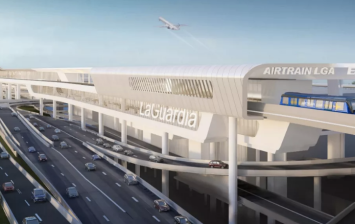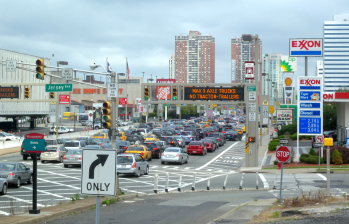OPINION: The Port Authority’s Wrong Moves at Newark Airport
The agency plans to replace the AirTrain and extend the PATH train — a bit. It should bring the PATH directly to the terminals.

The Port Authority of New York and New Jersey is planning to spend an astonishing $3.7 billion in order to extend the PATH train closer to Newark Airport, and rebuild the worn-out Newark AirTrain. Its ostensible goals are to improve access to and from New York City and to stoke economic development in the neighborhood adjacent to the Newark Airport Station.
Those plans, however, give short shrift to what should be two important goals of any transit project of this magnitude:
- building a rail link that will actually attract more riders than the 5 percent of airline passengers that use rail today to reach Newark Liberty
- reducing the parking and driving requirements at the airports, thus reducing CO2 emissions and making the airport more sustainable.

You would think a plan to spend that much money would transform how people get to the airport and reduce carbon-dioxide emissions — but nowhere in the project reports does the Port Authority say it. The plans to extend the PATH train (to a new station next to the existing Newark Airport Station, where it would connect with the AirTrain, NJTransit, and Amtrak) and rebuild the AirTrain, in fact, will not increase rail mode-share by airline passengers, which should raise alarms for anyone advocating for these projects.
The Port Authority should scrap these plans and focus instead on bringing heavy rail to the airport by extending the PATH train 1.5 more miles directly to the terminals, thus creating a one-seat ride from Manhattan. Other airports around the world have more direct airport rail services, which draw in greater share by rail, which in-turn helps to reduce ground CO2 emissions. The Regional Plan Association and Downtown Alliance both have advocated for such a one-seat ride, but current plans force a transfer between the rail (PATH) and the people mover (AirTrain) — a non-starter for airline travelers with luggage.
Until this year, the Port Authority legitimately could point to a Federal Aviation Administration rule that made designing direct rail links difficult. But an FAA announcement on Jan. 12 eliminated that restriction, opening the door for the Port Authority to use the “passenger facility fees” to design a heavy rail link, such as PATH, directly to the terminals — and potentially get rid of the AirTrain “people mover,” which forces passengers to transfer.
Yet the Port Authority issued a press release on May 5 highlighting its progress selecting a vendor for replacing the Newark AirTrain — making no mention of this critical rule change. Given the history and business model of the Port Authority, which depends heavily on parking revenues from all its airports, it’s easy to understand why the agency favors maintaining the status quo.
According to the Port Authority’s 2019 annual report, 34 percent of Port Authority revenues is derived from parking — to the tune of $400 million annually.
Today we issued a Request for Proposals (RFP) to four shortlisted teams to compete for a contract to design, build, operate and maintain a new 21st century, world-class AirTrain at @EWRairport. Learn more here: https://t.co/0XtAxWl0m3 pic.twitter.com/SS9T5bHcep
— Port Authority of NY & NJ (@PANYNJ) May 5, 2021
The RPA, which has advocated for transportation improvements in the New York metro area since 1929, noted in a November 2019 report that good coordination of the PATH extension and AirTrain replacement would be critical for the success of both projects.
“The AirTrain technology selected, AirTrain alignment and terminal connections, and the ultimate location of a rebuilt Terminal B all will affect PATH extension planning,” the RPA wrote. “Port Authority officials should share details about how the AirTrain and PATH extension projects are being coordinated to achieve the greatest possible economic and transit benefits.”
But those economic and transit benefits are not clearly stated by the RPA or in any Port Authority reports. How can we expect the Port Authority to design projects that will truly aim to reduce traffic, parking and CO2 emissions, and increase access by rail, if it won’t state specific targets or goals? In a metropolitan region that knows about climate change — remember Superstorm Sandy? — the Port Authority must state its goals and back up those targets with specific budget figures. As it is, the $3.7 billion investment to extend the PATH train and rebuild the AirTrain will do nothing to accomplish real transit ridership growth or improve environmental sustainability.
Extending the PATH train directly to the airport terminals also could save money, because the AirTrain replacement could be much smaller, if not eliminated altogether, with a design that truly thinks about airline-passenger transit needs.
The Port Authority’s silence so far on the FAA rule change and its insistence on replacing or building inferior people movers — both at Newark and LaGuardia Airport, as Streetsblog readers know — clearly signal that the agency has no plans or desire to increase mode share by rail.
Creating a real one-seat ride from Manhattan to the terminals via the PATH train would bring Newark into line with its peer airports around the globe. London’s Gatwick, for example, resembles Newark in many ways: Like Newark, it functions as a secondary airport to a larger facility (in its case, Heathrow); both it and Newark moved 46 million passengers in 2019. Gatwick, however, moves an impressive 39 percent of its airline passengers to/from the airport by train, according to its 2018 Master Plan, and is aiming for 48 percent.
The Port Authority projects that Newark’s passenger load will grow in coming years, to 72 million annually, and says that ridership of the refurbished AirTrain will rise to 18.5 million a year, from 12 million today. But two-thirds of the projected AirTrain ridership will be among terminals within the airport — same as today. So even with extending the PATH train, the Port Authority is not expecting to bring more than 2 million more riders to the airport by rail annually. Added to the 4 million that now use Amtrak and NJTransit, that’s 6 million of 72 million annual riders — or just 5 percent.

At $3.7 billion, the public deserves a better project with better outcomes — with the key goals of increasing rail mode-share and decreasing parking. Those goals, moreover, must be spelled out as targets that would be supervised by the Port Authority board and an outside entity with responsibility for holding the project to deadlines.
If we aim to promote sustainable, environmentally responsible travel, then decreasing parking and traffic congestion at the airport should not be so hard. Our elected officials, including the New Jersey governor, should be held accountable for the Port Authority’s lack of progress and its spending of so vast a sum to maintain the status quo that encourages people to drive to the airport. For much of the country, it is hard to make public transit work, but not in New York. We have rail, and we should make it accessible at our airports. If we are going to spend $3.7 billion, we must turn ground access to Newark Liberty in a more sustainable direction.
Bob Previdi is a transit consultant and a former planner and spokesman for NYC Transit.



